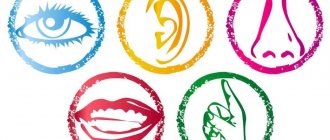This article was developed under the heading: Psychology.
Section: Feelings.
Every person is a social being. Therefore, when interacting with other people, it is common for us to experience various kinds of feelings. Each feeling that arises describes and characterizes our attitude towards something - to work, study, family, friends, a loved one. But where do feelings come from? What are feelings in general? I propose to consider together the features of these emotional processes in the human mind and body.
Each person has their own range of emotions, feelings and their manifestations
How many feelings does a person have?
As has long been known, humans have five basic senses. This opinion has been shared by the majority of scientists and ordinary citizens, as well as psychologists, for many centuries. The main feelings are considered to be:
- Vision;
- Touch;
- Hearing;
- Taste;
- Smell.
It is generally accepted that modern man has five main senses, thanks to which we can feel and understand the world around us, as well as ourselves.
These organs are: Eyes, ears, nose, tongue, skin All these senses can be felt thanks to our organs. Today, a lot of controversy has arisen regarding this matter. Many people began to question the established fact that humans have five senses. This opinion has been around for a long time, and is based on what a person feels thanks to his senses.
What are wishes
Lack of certain objects or sensations can also cause a certain feeling. Desire is one of the common forms of manifestation of needs. This is not just an awareness of the lack of any objects or sensations, but also the ability to clearly answer a number of questions posed:
- What exactly do I want? The ability to clearly identify an object for which there is a need or urgent need.
- Why do I want to? The ability to determine the motive that gave rise to the need for something.
- How to achieve the goal? Knowledge or search for certain paths or methods that allow you to obtain the desired object or achieve a certain state.
Human feelings associated with desires can arise for a variety of reasons. They can be caused by both internal and external factors. Speaking about the former, it is worth mentioning the personal need or lack of any benefits. Another reason for the emergence of desires may be following fashion, as well as the desire to imitate stronger individuals or leaders of a social group.
A feeling like desire can persist for a long time, or it can be quite permanent. In the first case, we can most often talk about emotional needs that cannot be met with material benefits. But desires associated with any specific objects or subjects may change or disappear altogether due to changing trends.
How are feelings different from emotions?
All our sensations are our experiences and relationships to the world around us. We can feel something thanks to our senses; humans have five such sensors. With their help, we receive and can analyze information from the world around us and perceive what is happening. So how many primary senses do humans actually have? Each of us has five senses, namely:
- Nose. Allows you to distinguish odors, determine the distance to its source, and navigate the area. This sense is called Smell;
- Leather. We can feel the ambient temperature, air humidity, and wind with our entire skin. Each of its cells reacts to stimuli and sends information to the brain, and we feel pain, heat or cold. This feeling is called touch;
- Ears. With their help, we can navigate space and hear what is happening around us. Hearing allows us to calculate the approximate distance from the sound source in order to react in time, for example, from falling snow from a roof or a falling tree;
- Language. It allows you to taste. The sense of taste helps to determine the degree of spoilage of food in order to consume the freshest food. Taste buds make it possible to distinguish between sour, sweet, salty, fried, and other tastes and flavors;
- Eyes. This complex biological device allows humans to see the world around them. Vision is the ability of a sighted person to receive information that enters the brain by converting electromagnetic radiation in the light range in the visual system of the body;
All the information that our brain processes comes through our senses, and then we form our perception and independent knowledge of ourselves and the world around us.
To understand how emotions differ from feelings, you need to spend a little time to study this issue well. One thing can be said, Feelings are acquired human qualities that can be developed throughout life, and emotions are embedded in our genetic code and manifest themselves from birth
For each person, the senses may be differently developed or formed. This way, some people will be able to feel more, while others will feel less. Those moments that bring us more emotional energy are stored in our memory. This can be both negative and positive manifestations. As a result, a certain emotional sensation is formed from the feelings received. Together with events, feelings can evoke in a person good or bad memories that carry a certain emotional connotation.
Slave morality
Lionel Trilling, author and literary critic, described a technique used by parents in middle and early grades. Not working and overworking their children's feelings causes them to seek approval for their feelings in the future. When children of lower-class and working-class families join the workforce, they are less prepared for emotional management than middle-class children. However, the working class and middle class complain of over-managing or micro-managing feelings that distract them from the real work. After all, what are these feelings? This is, first of all, our main way of interacting with the surrounding reality.
List of human feelings and emotions
The highly developed sensitivity of the human body allows one to receive more intense emotionality from the influence of external as well as internal factors. It follows that feelings can cause different emotions in people. All our emotions can be divided into two groups, positive and negative, these include such emotional feelings as:
- Positive emotions include three main states:
- Astonishment;
- Interest;
- Joy.
- And seven feelings that bring negative emotional coloring to people's lives. Such emotional manifestations can be classified as follows:
- Guilt;
- Charity;
- Fear;
- Suffering;
- Anger;
- Shame;
- Disgust.
Let's take a closer look at each state separately to understand the depth of a person's emotional state. But first, check out the table of human emotions.
To understand what feelings overcome you most often, you must first study the entire palette of emotional states. If you do not do this, then you will never be able to know yourself and the world around you.
Adequacy
Feelings are considered adequate if they correspond to the current situation. Because people want to fit into society and be considered normal, they constantly work on their feelings to fit the situation. Emotional labor is more about how people want to feel or how they want other people to see them. Feelings are not permanent, but continue because people constantly try to educate, suppress or manage them.
How to learn to manage your feelings
In order to effectively manage your feelings, you need to clearly classify your own emotional states. It is for this purpose that special criteria for classifying human feelings were developed.
To learn to control or manage your own emotions, you need to carefully study the criteria for choosing feelings and choose the most suitable option that can reflect your inner feeling or experience
Thus, a certain table of feelings was created that will allow each person to understand their own emotional states in order to determine and control their own feelings.
There are three main criteria by which feelings are divided, namely:
- Sthenicity;
- Valence;
- Intensity.
This classification table will help to characterize and understand difficult experiences, and divide them into types:
| CRITERIAS OF CHOICE | TYPES OF FEELINGS | ||
| Sthenicity | Stenic (encouraging extensive activity) | Asthenic (passive, relaxing) | |
| Valence | Positive | Negative | Neutral |
| Intensity | Strong | Weak | Medium in strength |
If a person experiences a strong sthenic sensation, for example, love. That weak manifestation of it is ordinary sympathy towards another person. Not each of us can define our experiences and sensations, since the number of sensory emotions is large. The definition of feelings can only be guessed at. Most of us, with great difficulty, can identify no more than ten of our own feelings, although we experience no less every day.
According to American psychologist Paul Ekman, there are 7 basic emotions, namely:
- Contempt is a negative feeling;
- Surprise - an indefinite reaction from a sudden action or expectation;
- Anger is a negative feeling that can provoke a person to commit a bad act, even a serious crime;
- Joy is one of the best manifestations of emotionality in a person, which can push him to incredible discoveries;
- Sadness is the negative side of all human feelings. A person who is sad is usually inactive and unable to engage in productive activities;
- Fear is an internal state of the human soul, which is formed for self-preservation;
- Disgust also has a negative connotation of emotionality. Just like fear, it helps a person preserve his own body.
High emotionality of a person can change a person’s attitude towards the world around him.
In order to act correctly in a given situation, you first need to understand your inner state and then learn to avoid excessive emotional outbursts that can cause harm to you. No matter what feelings you are experiencing, the following table will help you find a name for the emotional experience of human feelings, based on the four basic emotions:
| INITIAL EMOTION | RELATED FEELINGS |
| Joy | Ecstasy, euphoria, delight, confidence, relief, tenderness, curiosity, cheerfulness, peace, revitalization, happiness, optimism, compassion, dignity, peace, compassion, love, bliss, satisfaction, etc. |
| Anger | Annoyance, neglect, dissatisfaction, cynicism, jealousy, hatred, rage, rage, anger, aggression, disgust, envy, disgust, contempt, intolerance, disgust, etc. |
| Sadness | Fatigue, shame, apathy, concern, despair, sadness, boredom, guilt, resentment, depression, oppression, weakness, melancholy, etc. |
| Fear | Confusion, doubt, uncertainty, worry, nervousness, apprehension, anxiety, confusion, uncertainty, panic, mistrust, etc. |
Using these tables, you can clearly understand what feelings cover you at a certain moment in life. In this way, you can understand your internal state and prevent negative influence on the people around you. You can also, after studying this list of emotional states, characterize another person, if necessary.
Diagnostics
Emotions in psychology, classification and their functional role, are studied with the aim of determining the mood and general state of a person, identifying brightly colored negative reactions and finding ways out of them, self-control of one’s emotional background and its stability.
Diagnosis of emotions is carried out in several areas:
- Observation - physiological changes in the body are analyzed (blood pressure, pulse, skin temperature, analysis of facial expressions, speech).
- Questionnaires are the most common and informative diagnostic method aimed at identifying a person’s leading emotions using specially designed tests. The method is also used to determine self-assessment of emotional state.
- To establish the leading emotions, the differential scale of K. Izard (1976) was developed. It consists of 10 fundamental emotions, characterized by 3 meanings, with which one’s own feelings are compared. These values are assigned points, after which the well-being coefficient is calculated.
- M. Luscher color test (1949) – connects the emotional state with the light sensitivity of the eyes. It assumes that certain emotions are associated with certain colors, and a person must correlate 1 of 8 colors with a given question. Warm shades (red-yellow) indicate the presence of positive emotions and good mood, cold tones signal the presence of negative emotions.
- The scale for assessing the significance of emotions according to B.I. Dodonov (1977) is a ranking of preferences in emotions according to 10 criteria (from the most significant to the least significant) in order to determine the prevailing needs (biological, cognitive, social).
For young children, the most commonly used method for assessing emotional stability using drawings (methods Cactus, Family Drawing).
Questioning is a type of survey conducted in writing by filling out questionnaire forms. It is often used to survey a group of people both statically (once) and dynamically (repeated survey after a certain time).
You can undergo a clinical psychological or neuropsychological examination in Moscow at the following clinics:
- M-Vita, st. Zelenogradskaya, 39, building 1 – from 1500 to 2500 rubles;
- ABC medicine, st. Stoletova, 19 – 1100 rubles;
- Alliancek KRK, st. Tsyurupy, 1, building 6 – 4000 rubles;
- Family clinic, st. Pervomaiskaya, 42 – 3300 rubles;
- Treatment center, st. Timur Frunze, 15/1 – 2900 rub.
You can consult a psychotherapist at a private doctor or at one of the clinics in Moscow:
- Capital, Prospekt Mira, 12, building 3 – 3000 rubles;
- M-Vita, st. Zelenogradskaya, 39, building 1 – 2000 rubles;
- Fomina Clinic, st. Dolgorukovskaya, 17, building 1 – 6000 rubles;
- Alliancek KRK, st. Tsyurupy, 1, building 6 – 3000 rub.
Division of feelings into three varieties
In order not to fall into a depressed state, a person must realize that how he will deal with his inner experiences depends only on him.
A long stay in oppression can develop into a chronic psychological illness. To understand what feelings there are, you can guess and make a lot of assumptions. After all, each of us can perceive certain feelings differently. Some people are capable of experiencing experiences very deeply and for a long time, while others are given the ability to have short-term emotional experiences. Each person is able to feel depending on his character, principle or accumulated experience in life, and the difference in feelings also depends on the person’s temperament.
Moral feelings
They manifest themselves in people in relation to each other or in relation to their own actions. As a rule, the classification of feelings is determined by the subject’s sphere of residence in society. This gives rise to the following emotional manifestations:
- hatred;
- Love;
- sympathy;
- antipathy;
- charity;
- respect for other subjects;
- feeling of conscience, gratitude.
This also includes friendship and collective affection.
All these qualities manifest themselves depending on the norms of moral behavior accepted in social society. In addition, such sensations can be caused depending on a person’s worldview and his outlook on life and established beliefs. In the case when an action corresponds to accepted moral standards, a person will feel satisfaction, but if actions do not correspond to recognized canons, then people will feel dissatisfied.
Intellectual feelings
Mental experience caused by mental activity. When a person gets positive results from his work, he will feel joy, peace and joy. Such feelings motivate people to make new discoveries or become more productive. But if you fail in your endeavors, then there will be a feeling of frustration and painful perception that will cause reduced efficiency or complete refusal to complete any tasks.
Aesthetic feelings
When you witness something beautiful, you will receive a lot of positive emotions. When contemplating beautiful landscapes, objects of art, looking at talented people or creating beautiful creations, you begin to experience a feeling of delight and bliss that gives you strength for new discoveries and motivates you to do great things.
This is not a complete list; in fact, the palette of emotions and feelings is so vast that it is impossible to describe in words all emotional experiences. But, nevertheless, this is more than enough to classify the main emotional components.
Classification by types and scope of manifestation
Feelings are varied and sometimes a person cannot explain what he is experiencing. To simplify the assessment process, you should use the classification of types of feelings in psychology:
- Subject - refer to the basic spheres of human reality. They show reactions to various actions of others: irritation, delight, surprise, anger.
- Intellectual - desire for new experiences: curiosity, anticipation, doubt.
- Aesthetic - a reaction to beautiful, ugly objects: experiences of admiration, disgust, pleasure, dissatisfaction.
- Praxic - associated with the choice of activity. They determine the attitude towards responsibilities: determination, thirst for knowledge, satisfaction.
- Moral - responsible for the interaction of people, personal assessment of what is permissible and unacceptable: patriotism, love, cruelty, selfishness.
Complex feelings cannot be classified into one category; they are always a combination of 2-3 different experiences. For example, love can encourage one to gain knowledge, change activities, and unlock potential. Resentment can cause irritation, despair, and apathy.
What is the actual difference between feelings and emotions?
When experiencing certain emotional experiences, we feel positive or negative emotions with all the sensors of our body. Not everyone can express such worries in verbal form. However, understanding feelings allows us not only to identify them qualitatively, but also to completely control these emotional experiences.
It is very important not to confuse emotions and feelings, since there are many opinions on this matter. Many people believe that these are the same thing. But in reality this is completely wrong
As we have already found out, feelings are a set of certain experiences in relation to the people around us, as well as objects around us or some events.
Many individuals interpret the words “feelings” and “emotions” differently: Some believe that they are the same thing, others are sure that feelings are a type of human emotional state. But there are those who think that emotions are the mental state of a living organism, and feelings are properties of the mental state. Any opinion has a place to be, since in reality feelings and emotions are interconnected. Thanks to these spiritual experiences, we can enjoy our lives, but without them we would simply exist. This emotional palette makes our lives varied and exciting, and each of us finds the meaning of life thanks to these sensations.
It is very important to learn to control your own feelings and emotions so as not to fall into a state of depression or apathy. If a person remains in this state for a long time. then it will be very difficult to return him to normal life and make him happy
So what is the difference between feelings and emotions? In fact, there are specific differences, namely:
Each of us is filled with emotions from birth. These are instinctive reactions of people that change depending on changes in the world around us, and feelings develop throughout our lives in social society. We acquire the ability to feel as a result of our upbringing and knowledge, that is, training. As everyone knows, we have been able to express emotions since our birth, but people learn to feel throughout their lives.
Human feelings are easier to control, but emotional attitude cannot be controlled, since it is part of our instinctive nature.
As a rule, feelings can change during a person’s life, they can either progress and develop, or completely disappear; their manifestation can take place in different ways and completely change their “polarity”. Emotion is always the same.
When a person experiences a negative feeling towards an object or another person, then such an attitude can change at any moment, and develop into the opposite feeling - for example, if you experience hatred, then such a feeling can change into a feeling of love for some object. But, the reason for fear always remains unchanged; if you experience this emotion, then there is no likelihood of it changing, since there is an instinctive reason for this. There are two options: either you are afraid of something or not.
The main motivation is a feeling, and emotion causes a short-term desire to do something and make it a reality.
Danger
Feelings can lead to harm. When a person is dealing with an overwhelming amount of stress and problems in their life, it can lead to self-harm. When a person is in a good state, he never wants that state to end; on the contrary, when someone is in a bad state, they want that feeling to go away. Self-harm or pain is sometimes the answer for many people because they want something to distract them from the real problem. These people cut themselves, stab themselves, and starve themselves in an attempt to feel something other than what they are currently feeling because they believe the pain is not as bad as their actual problem. Distraction is not the only reason many people choose to self-harm. Some people self-harm to punish themselves for feeling certain ways.
A “gut feeling” is a visceral emotional reaction to something. It can be negative, such as a feeling of anxiety, or positive, such as a feeling of trust. It is usually seen as not being modulated by conscious thought, and sometimes as a feature of intuition rather than rationality. Other people's feelings are often picked up by us, and they are not always positive.
This strictly vernacular term can also be used as shorthand for an individual's "common sense" perception of what is considered the "right thing", such as helping an injured passerby, avoiding dark alleys, and acting on one's gut feelings about a given situation. It can also refer to simple, commonly known phrases that are true no matter when said, such as “Water is wet” or “Fire is hot,” or ideas that an individual intuitively perceives to be true (such as “rightness”).
How to learn to control your feelings
In those moments when emotional experiences capture our consciousness, regardless of whether they are positive or negative, the psychological shell of a person suffers. To experience well-being, you need to know how to properly cope with negative or positive feelings. Both of them can cause serious damage to a person’s moral and physical health. Therefore, you need to know the measure of joy and sorrow.
It is very important to understand the boundary between positive and negative emotions. The first step to learning to control your feelings and emotions is to study basic emotional manifestations. You just need to choose the most suitable option from the tables that are located above in the text
In order to control your inner experiences, you need to treat your emotional mood correctly. Therefore you need to consider the following:
- First, you must identify the criteria for your feelings as indicated in the first table. These are sthenicity, valence and intensity. After this, move on to the second stage.
- Select the initial emotion from the second table. Think about which feelings from this list suit you best.
- And finally, determine the name of your emotional state, and independently understand what emotional disturbances are troubling you.
Very often our inner experiences overcome a person’s mind, such that he cannot live in peace. He loses his appetite, suffers from insomnia, and the most negative thoughts creep in that harm the entire body. The longer severe unrest lasts, the greater the likelihood of self-harm and being in a long-term depressive state. Long-term stress has a detrimental effect on a person, and accordingly, the people around him begin to suffer.
To learn how to manage your internal state, each person must choose his own table of feelings in order to become more successful and not endanger his life and the lives of his loved ones.
Age stages of development
The development of feelings in early childhood is an important, complex process. It happens in stages:
- Newborn baby. Once born, a child masters the basic forms of manifestations necessary for survival: hunger, pleasure, pain, fear. The emotional state depends on physical sensations. A newborn does not know how to distinguish between feelings. His main interest and need is physical contact with his mother. The baby reacts to her mood and copies it.
- From 0 to 6 months. The baby understands what sensations he experiences when in contact with adults. His perception is fragmentary: he sees the world in parts. By six months, he learns to distinguish between family and strangers; anxiety and wariness appear in his arsenal. While exploring the world, he tries to touch everything he sees. If this fails, the baby experiences anger and discomfort.
- 6–12 months Six-month-old babies know how to be surprised and show interest. In addition to physical needs, the child has mental ones. Interests gradually form: the child divides toys into favorites and unloved ones. At the age of 8 months, fear of separation from the mother appears, the child experiences anxiety and becomes restless.
- 1–1.5 years. Own desires appear, the need to realize them. The child learns to make independent decisions, but often faces prohibitions from adults. An obstacle causes anger and a desire to get what is yours. At this age, it is important to learn to separate desires and actions. The main achievement of 1.5 years is that the child develops an idea of himself, the baby identifies himself with his name.
- 1.5–2 years The child is no longer helpless. He moves confidently, can pick up a toy himself, and has more freedom and needs. He strives to prove independence, the right to his own opinion. At this age, he already shares feelings, but cannot name them.
- 2–2.5 years Two-year-old children see themselves as the center of the world; they have no understanding of danger. Also, the feeling of compassion and pity has not yet been formed: if the child does not like another baby, he may hit him or bite him, expressing hostility.
- 2.5–3 years. With successful development, by the age of three the child will have formed a holistic idea of himself. There is pride in one’s independence and shame in case of failure. Interest in other children awakens, the desire to take their place in the team.
The development of feelings continues until the end of adolescence. The first years of life form the foundation that will help a child differentiate feelings from emotions.
Adaptation of a child in a team
At the end it says
We now know how many basic senses humans have and how they can help people feel. In addition, we figured out what emotions are and how feelings relate to them. It is quite difficult to count the exact number of emotions and feelings, since there are a large number of them. Some say that there are only 5 of them. Some people think that there are more than 15, and others cannot decide on the number at all, thinking that there are many more of them. But, based on scientific research, we can safely say that there are 5 main organs. They allow us humans to feel. Although there are some contradictions on this issue, these are just modern assumptions.
Stimulus-response
How we see other people expressing their emotions or feelings determines how we react. The way a person reacts to a situation is based on feeling rules. If a person is not aware of the situation, the way they react will be a completely different behavior than if they were informed of the situation. For example, if a tragic event occurred and they knew about it, their response would be sympathetic to the situation. If they are unaware of the situation, then their response may be indifferent. A lack of knowledge or information about an event can determine how a person sees things and how they react to them. These are feelings that everyone is familiar with.
Two poles of empathy
Another important topic is empathy, the ability to empathize and feel emotionally for another person.
In addictive families, the empathy mechanism is not optimal, and polarities usually appear.
Lack of empathy, emotional coldness and callousness
True feelings are suppressed, empathy is presented as something threatening. But in some cases, the empathy mechanism was simply not developed enough in early childhood. If a child's environment has not been empathic, he cannot learn empathy. The age of up to one and a half years is especially important here.
Empathy is excessive, the boundary is blurred, a symbiotic relationship arises
Other people's feelings and pain are perceived as their own. This is the so-called “contact without borders”, in which it is easy to lose yourself. Most often, this type of contact is a consequence of fixation in the oral symbiotic period, when the child and mother seem to be a single whole.
Dependent personalities often develop along the path of insufficient empathy; codependent individuals - along the path of excessive empathy
It is important to normalize the mechanism of empathy, to come to a balance between feeling another person and being attuned to oneself











